Fairfield Business: Toyota Marketing in UK's Automotive Sector
VerifiedAdded on 2020/11/12
|10
|3054
|76
Report
AI Summary
This report provides a comprehensive analysis of Toyota's marketing strategies within the UK automotive industry. It begins with an introduction to marketing and then focuses on Toyota, a multinational automotive manufacturer. The report delves into the UK's automotive market, highlighting its significance to the economy and the changing customer needs. It examines the macro factors impacting Toyota, using a PESTLE analysis to explore political, economic, social, technological, legal, and environmental factors. A SWOT analysis is conducted to assess Toyota's strengths, weaknesses, opportunities, and threats. The report then details Toyota's marketing mix, covering product, price, place, promotion, people, and process strategies. The conclusion summarizes the key findings and insights into Toyota's marketing approach. The report is a detailed study of Toyota's marketing in the UK, covering various aspects like market analysis, competitive strategies, and marketing mix elements.
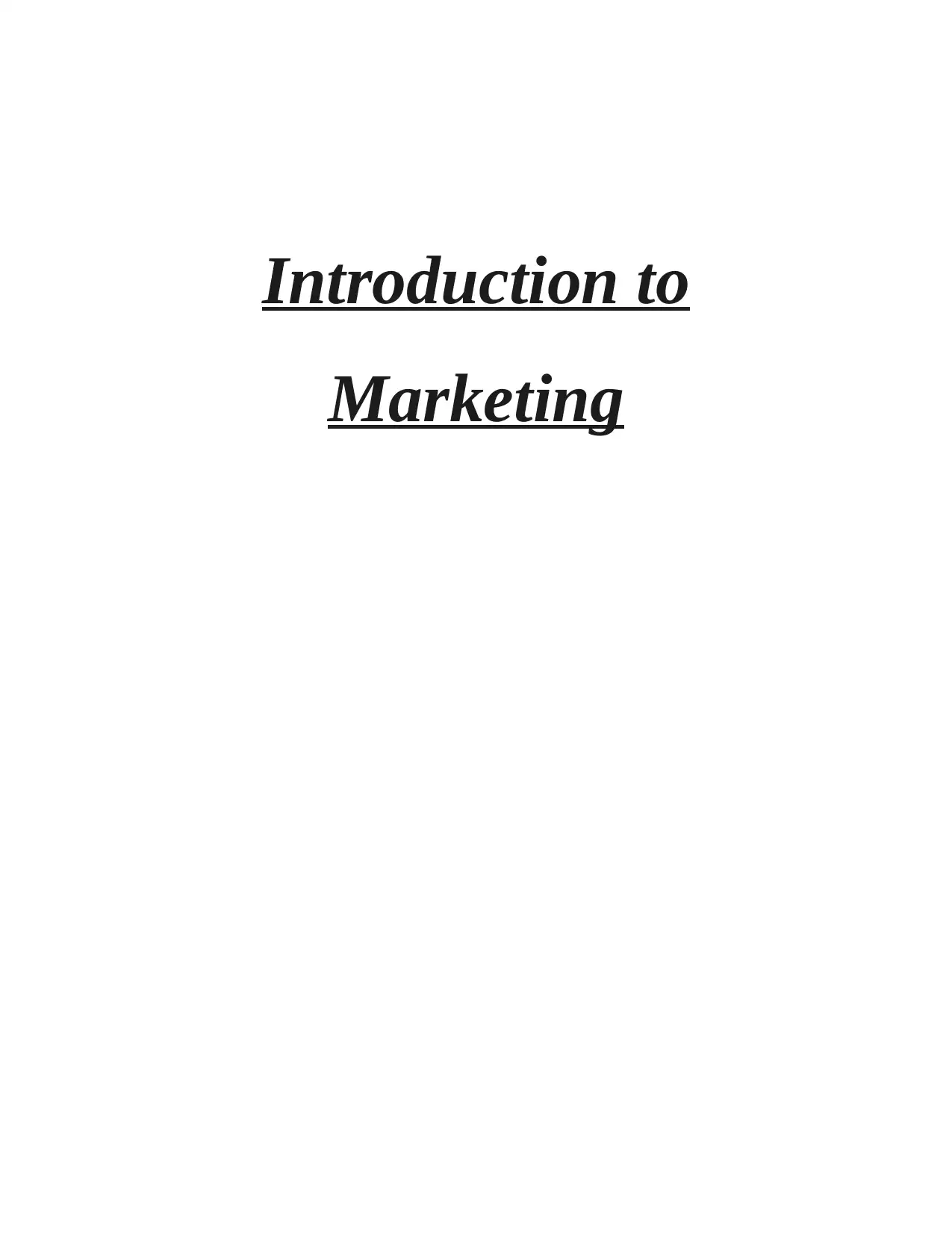
Introduction to
Marketing
Marketing
Paraphrase This Document
Need a fresh take? Get an instant paraphrase of this document with our AI Paraphraser
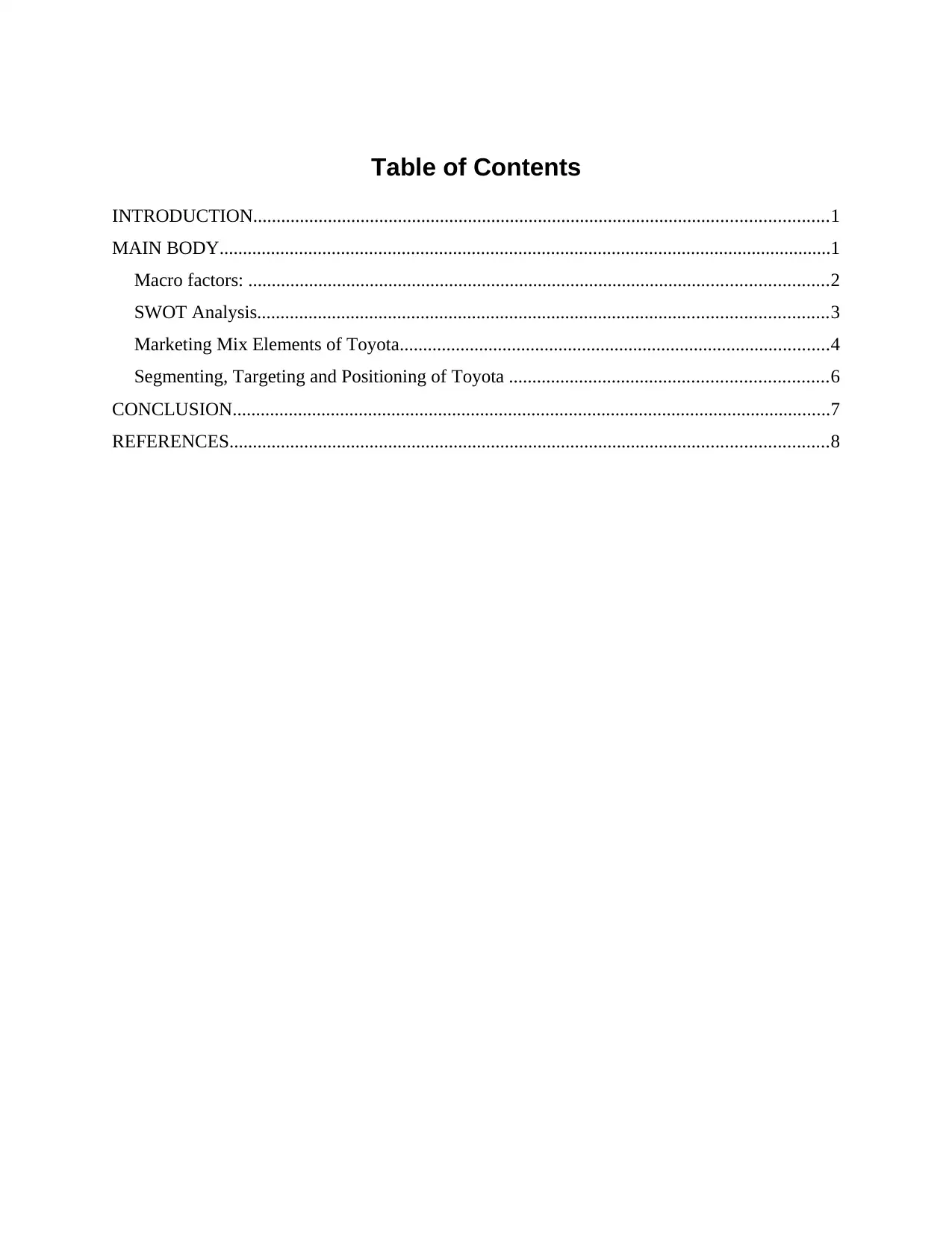
Table of Contents
INTRODUCTION...........................................................................................................................1
MAIN BODY...................................................................................................................................1
Macro factors: ............................................................................................................................2
SWOT Analysis..........................................................................................................................3
Marketing Mix Elements of Toyota............................................................................................4
Segmenting, Targeting and Positioning of Toyota ....................................................................6
CONCLUSION................................................................................................................................7
REFERENCES................................................................................................................................8
INTRODUCTION...........................................................................................................................1
MAIN BODY...................................................................................................................................1
Macro factors: ............................................................................................................................2
SWOT Analysis..........................................................................................................................3
Marketing Mix Elements of Toyota............................................................................................4
Segmenting, Targeting and Positioning of Toyota ....................................................................6
CONCLUSION................................................................................................................................7
REFERENCES................................................................................................................................8
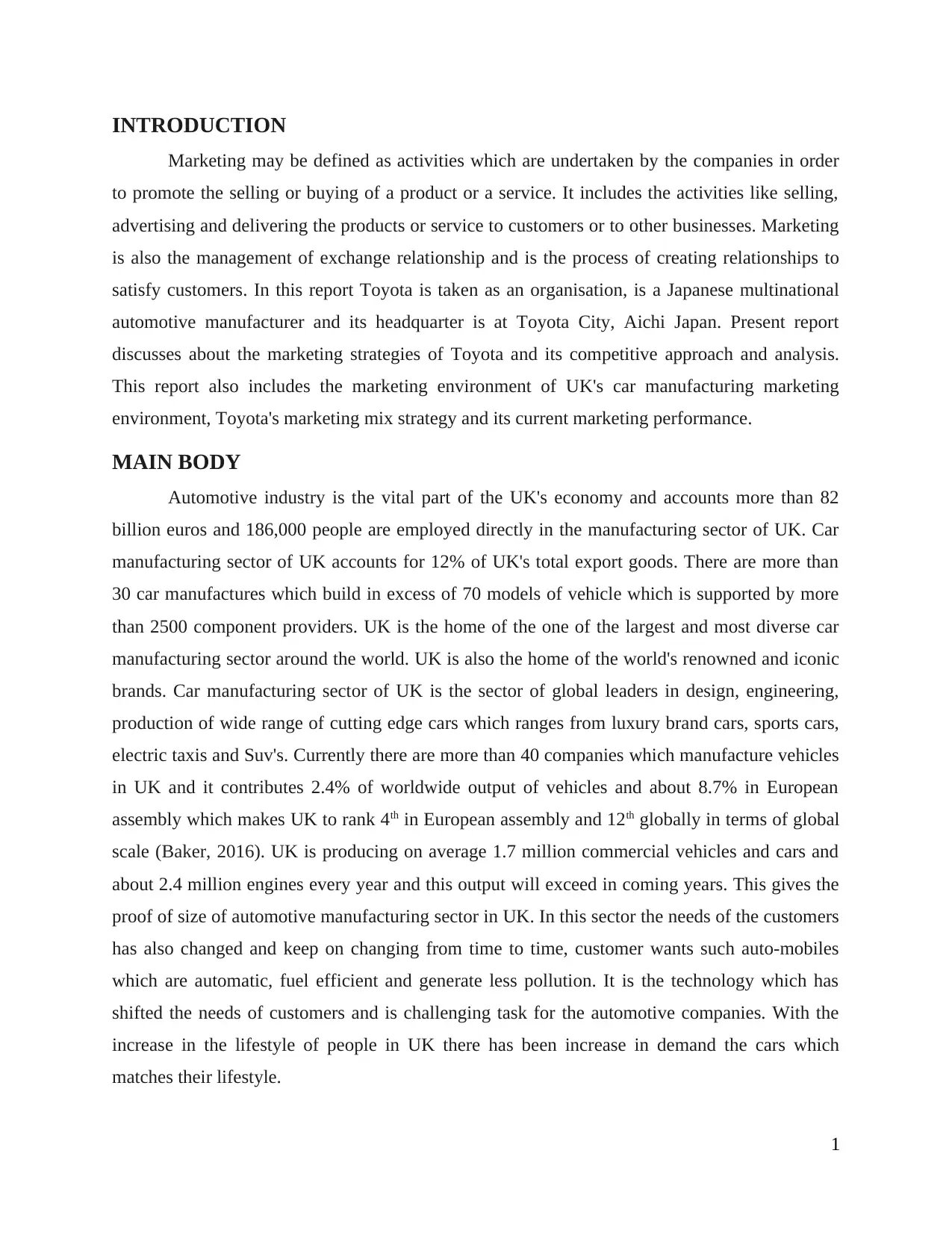
INTRODUCTION
Marketing may be defined as activities which are undertaken by the companies in order
to promote the selling or buying of a product or a service. It includes the activities like selling,
advertising and delivering the products or service to customers or to other businesses. Marketing
is also the management of exchange relationship and is the process of creating relationships to
satisfy customers. In this report Toyota is taken as an organisation, is a Japanese multinational
automotive manufacturer and its headquarter is at Toyota City, Aichi Japan. Present report
discusses about the marketing strategies of Toyota and its competitive approach and analysis.
This report also includes the marketing environment of UK's car manufacturing marketing
environment, Toyota's marketing mix strategy and its current marketing performance.
MAIN BODY
Automotive industry is the vital part of the UK's economy and accounts more than 82
billion euros and 186,000 people are employed directly in the manufacturing sector of UK. Car
manufacturing sector of UK accounts for 12% of UK's total export goods. There are more than
30 car manufactures which build in excess of 70 models of vehicle which is supported by more
than 2500 component providers. UK is the home of the one of the largest and most diverse car
manufacturing sector around the world. UK is also the home of the world's renowned and iconic
brands. Car manufacturing sector of UK is the sector of global leaders in design, engineering,
production of wide range of cutting edge cars which ranges from luxury brand cars, sports cars,
electric taxis and Suv's. Currently there are more than 40 companies which manufacture vehicles
in UK and it contributes 2.4% of worldwide output of vehicles and about 8.7% in European
assembly which makes UK to rank 4th in European assembly and 12th globally in terms of global
scale (Baker, 2016). UK is producing on average 1.7 million commercial vehicles and cars and
about 2.4 million engines every year and this output will exceed in coming years. This gives the
proof of size of automotive manufacturing sector in UK. In this sector the needs of the customers
has also changed and keep on changing from time to time, customer wants such auto-mobiles
which are automatic, fuel efficient and generate less pollution. It is the technology which has
shifted the needs of customers and is challenging task for the automotive companies. With the
increase in the lifestyle of people in UK there has been increase in demand the cars which
matches their lifestyle.
1
Marketing may be defined as activities which are undertaken by the companies in order
to promote the selling or buying of a product or a service. It includes the activities like selling,
advertising and delivering the products or service to customers or to other businesses. Marketing
is also the management of exchange relationship and is the process of creating relationships to
satisfy customers. In this report Toyota is taken as an organisation, is a Japanese multinational
automotive manufacturer and its headquarter is at Toyota City, Aichi Japan. Present report
discusses about the marketing strategies of Toyota and its competitive approach and analysis.
This report also includes the marketing environment of UK's car manufacturing marketing
environment, Toyota's marketing mix strategy and its current marketing performance.
MAIN BODY
Automotive industry is the vital part of the UK's economy and accounts more than 82
billion euros and 186,000 people are employed directly in the manufacturing sector of UK. Car
manufacturing sector of UK accounts for 12% of UK's total export goods. There are more than
30 car manufactures which build in excess of 70 models of vehicle which is supported by more
than 2500 component providers. UK is the home of the one of the largest and most diverse car
manufacturing sector around the world. UK is also the home of the world's renowned and iconic
brands. Car manufacturing sector of UK is the sector of global leaders in design, engineering,
production of wide range of cutting edge cars which ranges from luxury brand cars, sports cars,
electric taxis and Suv's. Currently there are more than 40 companies which manufacture vehicles
in UK and it contributes 2.4% of worldwide output of vehicles and about 8.7% in European
assembly which makes UK to rank 4th in European assembly and 12th globally in terms of global
scale (Baker, 2016). UK is producing on average 1.7 million commercial vehicles and cars and
about 2.4 million engines every year and this output will exceed in coming years. This gives the
proof of size of automotive manufacturing sector in UK. In this sector the needs of the customers
has also changed and keep on changing from time to time, customer wants such auto-mobiles
which are automatic, fuel efficient and generate less pollution. It is the technology which has
shifted the needs of customers and is challenging task for the automotive companies. With the
increase in the lifestyle of people in UK there has been increase in demand the cars which
matches their lifestyle.
1
⊘ This is a preview!⊘
Do you want full access?
Subscribe today to unlock all pages.

Trusted by 1+ million students worldwide
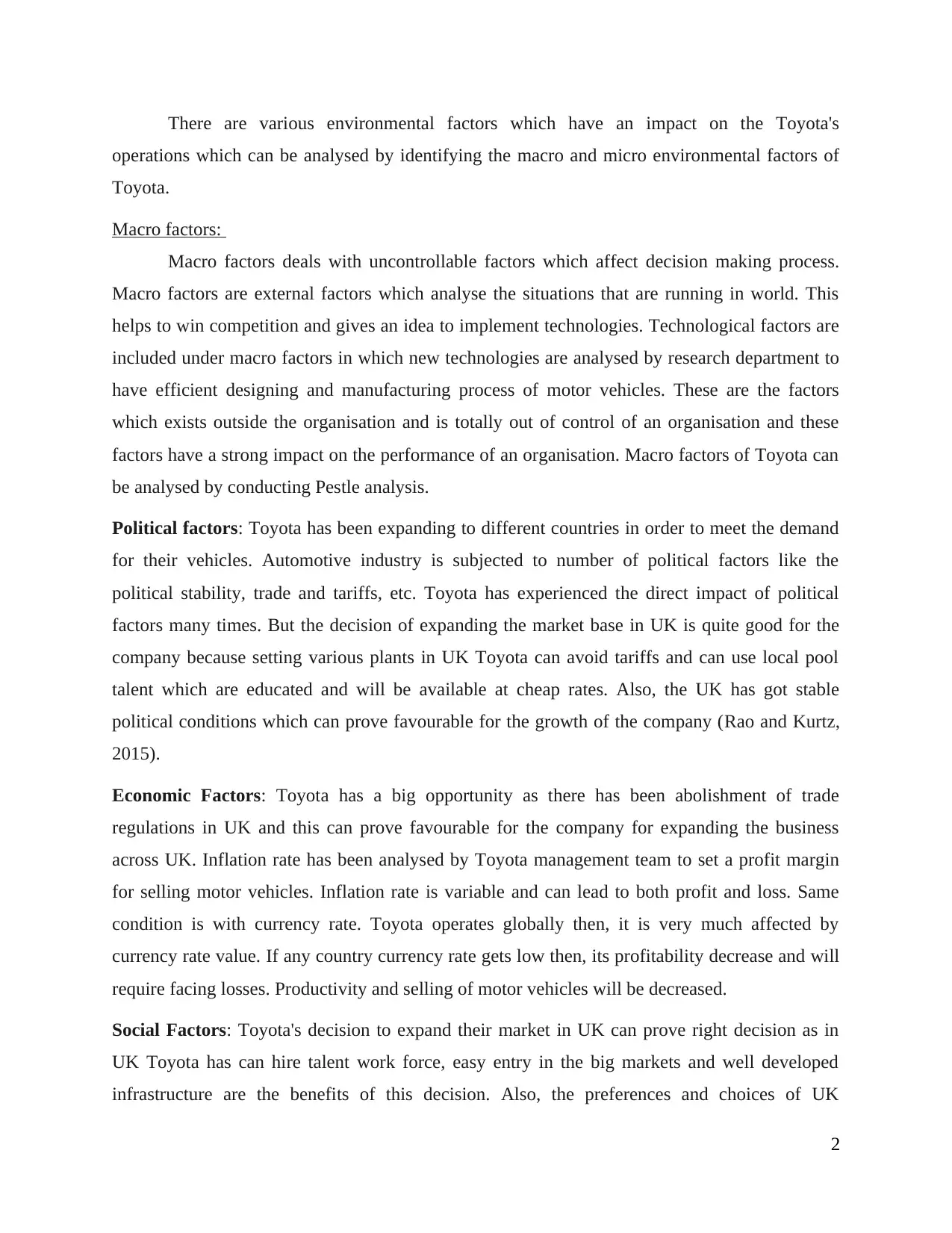
There are various environmental factors which have an impact on the Toyota's
operations which can be analysed by identifying the macro and micro environmental factors of
Toyota.
Macro factors:
Macro factors deals with uncontrollable factors which affect decision making process.
Macro factors are external factors which analyse the situations that are running in world. This
helps to win competition and gives an idea to implement technologies. Technological factors are
included under macro factors in which new technologies are analysed by research department to
have efficient designing and manufacturing process of motor vehicles. These are the factors
which exists outside the organisation and is totally out of control of an organisation and these
factors have a strong impact on the performance of an organisation. Macro factors of Toyota can
be analysed by conducting Pestle analysis.
Political factors: Toyota has been expanding to different countries in order to meet the demand
for their vehicles. Automotive industry is subjected to number of political factors like the
political stability, trade and tariffs, etc. Toyota has experienced the direct impact of political
factors many times. But the decision of expanding the market base in UK is quite good for the
company because setting various plants in UK Toyota can avoid tariffs and can use local pool
talent which are educated and will be available at cheap rates. Also, the UK has got stable
political conditions which can prove favourable for the growth of the company (Rao and Kurtz,
2015).
Economic Factors: Toyota has a big opportunity as there has been abolishment of trade
regulations in UK and this can prove favourable for the company for expanding the business
across UK. Inflation rate has been analysed by Toyota management team to set a profit margin
for selling motor vehicles. Inflation rate is variable and can lead to both profit and loss. Same
condition is with currency rate. Toyota operates globally then, it is very much affected by
currency rate value. If any country currency rate gets low then, its profitability decrease and will
require facing losses. Productivity and selling of motor vehicles will be decreased.
Social Factors: Toyota's decision to expand their market in UK can prove right decision as in
UK Toyota has can hire talent work force, easy entry in the big markets and well developed
infrastructure are the benefits of this decision. Also, the preferences and choices of UK
2
operations which can be analysed by identifying the macro and micro environmental factors of
Toyota.
Macro factors:
Macro factors deals with uncontrollable factors which affect decision making process.
Macro factors are external factors which analyse the situations that are running in world. This
helps to win competition and gives an idea to implement technologies. Technological factors are
included under macro factors in which new technologies are analysed by research department to
have efficient designing and manufacturing process of motor vehicles. These are the factors
which exists outside the organisation and is totally out of control of an organisation and these
factors have a strong impact on the performance of an organisation. Macro factors of Toyota can
be analysed by conducting Pestle analysis.
Political factors: Toyota has been expanding to different countries in order to meet the demand
for their vehicles. Automotive industry is subjected to number of political factors like the
political stability, trade and tariffs, etc. Toyota has experienced the direct impact of political
factors many times. But the decision of expanding the market base in UK is quite good for the
company because setting various plants in UK Toyota can avoid tariffs and can use local pool
talent which are educated and will be available at cheap rates. Also, the UK has got stable
political conditions which can prove favourable for the growth of the company (Rao and Kurtz,
2015).
Economic Factors: Toyota has a big opportunity as there has been abolishment of trade
regulations in UK and this can prove favourable for the company for expanding the business
across UK. Inflation rate has been analysed by Toyota management team to set a profit margin
for selling motor vehicles. Inflation rate is variable and can lead to both profit and loss. Same
condition is with currency rate. Toyota operates globally then, it is very much affected by
currency rate value. If any country currency rate gets low then, its profitability decrease and will
require facing losses. Productivity and selling of motor vehicles will be decreased.
Social Factors: Toyota's decision to expand their market in UK can prove right decision as in
UK Toyota has can hire talent work force, easy entry in the big markets and well developed
infrastructure are the benefits of this decision. Also, the preferences and choices of UK
2
Paraphrase This Document
Need a fresh take? Get an instant paraphrase of this document with our AI Paraphraser
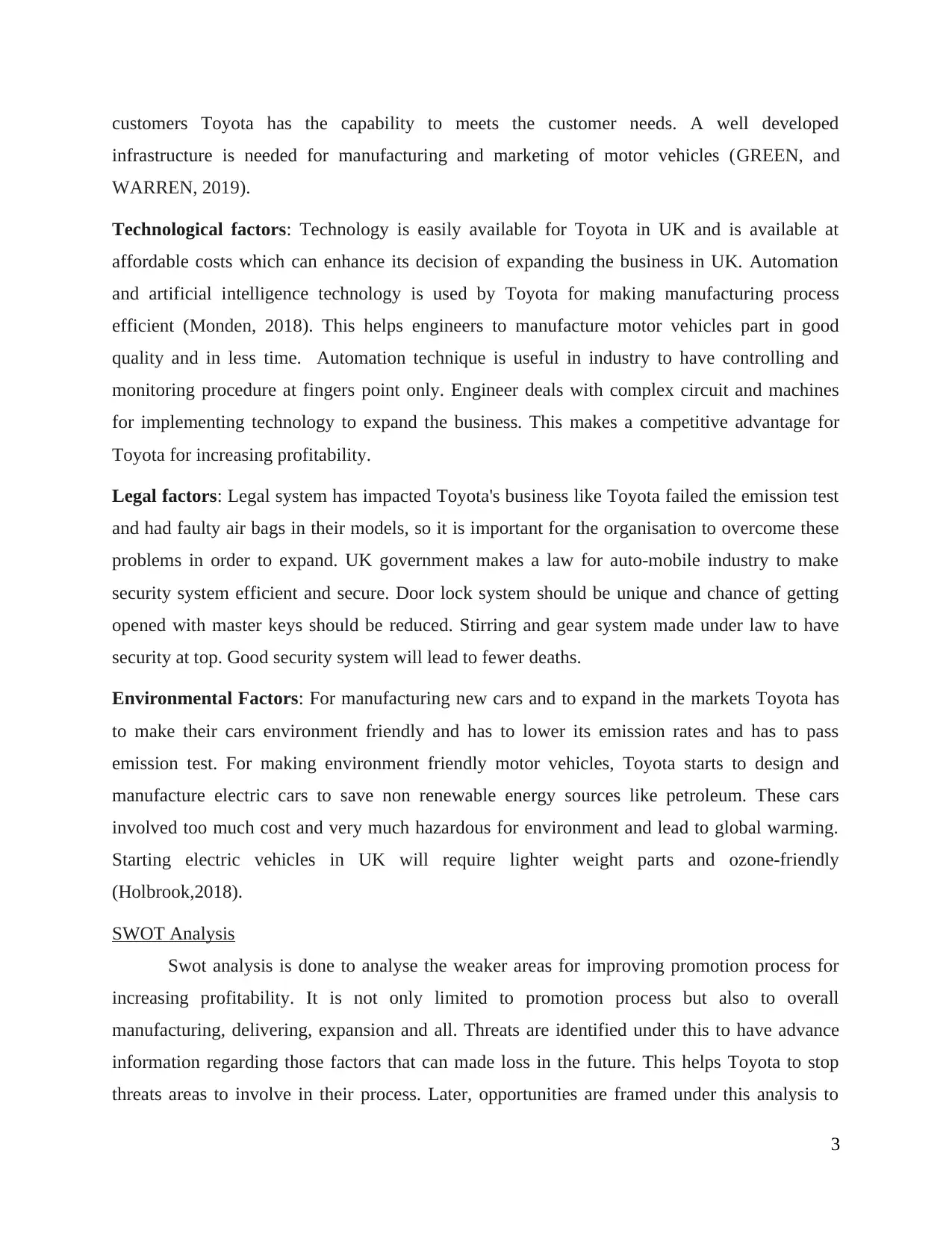
customers Toyota has the capability to meets the customer needs. A well developed
infrastructure is needed for manufacturing and marketing of motor vehicles (GREEN, and
WARREN, 2019).
Technological factors: Technology is easily available for Toyota in UK and is available at
affordable costs which can enhance its decision of expanding the business in UK. Automation
and artificial intelligence technology is used by Toyota for making manufacturing process
efficient (Monden, 2018). This helps engineers to manufacture motor vehicles part in good
quality and in less time. Automation technique is useful in industry to have controlling and
monitoring procedure at fingers point only. Engineer deals with complex circuit and machines
for implementing technology to expand the business. This makes a competitive advantage for
Toyota for increasing profitability.
Legal factors: Legal system has impacted Toyota's business like Toyota failed the emission test
and had faulty air bags in their models, so it is important for the organisation to overcome these
problems in order to expand. UK government makes a law for auto-mobile industry to make
security system efficient and secure. Door lock system should be unique and chance of getting
opened with master keys should be reduced. Stirring and gear system made under law to have
security at top. Good security system will lead to fewer deaths.
Environmental Factors: For manufacturing new cars and to expand in the markets Toyota has
to make their cars environment friendly and has to lower its emission rates and has to pass
emission test. For making environment friendly motor vehicles, Toyota starts to design and
manufacture electric cars to save non renewable energy sources like petroleum. These cars
involved too much cost and very much hazardous for environment and lead to global warming.
Starting electric vehicles in UK will require lighter weight parts and ozone-friendly
(Holbrook,2018).
SWOT Analysis
Swot analysis is done to analyse the weaker areas for improving promotion process for
increasing profitability. It is not only limited to promotion process but also to overall
manufacturing, delivering, expansion and all. Threats are identified under this to have advance
information regarding those factors that can made loss in the future. This helps Toyota to stop
threats areas to involve in their process. Later, opportunities are framed under this analysis to
3
infrastructure is needed for manufacturing and marketing of motor vehicles (GREEN, and
WARREN, 2019).
Technological factors: Technology is easily available for Toyota in UK and is available at
affordable costs which can enhance its decision of expanding the business in UK. Automation
and artificial intelligence technology is used by Toyota for making manufacturing process
efficient (Monden, 2018). This helps engineers to manufacture motor vehicles part in good
quality and in less time. Automation technique is useful in industry to have controlling and
monitoring procedure at fingers point only. Engineer deals with complex circuit and machines
for implementing technology to expand the business. This makes a competitive advantage for
Toyota for increasing profitability.
Legal factors: Legal system has impacted Toyota's business like Toyota failed the emission test
and had faulty air bags in their models, so it is important for the organisation to overcome these
problems in order to expand. UK government makes a law for auto-mobile industry to make
security system efficient and secure. Door lock system should be unique and chance of getting
opened with master keys should be reduced. Stirring and gear system made under law to have
security at top. Good security system will lead to fewer deaths.
Environmental Factors: For manufacturing new cars and to expand in the markets Toyota has
to make their cars environment friendly and has to lower its emission rates and has to pass
emission test. For making environment friendly motor vehicles, Toyota starts to design and
manufacture electric cars to save non renewable energy sources like petroleum. These cars
involved too much cost and very much hazardous for environment and lead to global warming.
Starting electric vehicles in UK will require lighter weight parts and ozone-friendly
(Holbrook,2018).
SWOT Analysis
Swot analysis is done to analyse the weaker areas for improving promotion process for
increasing profitability. It is not only limited to promotion process but also to overall
manufacturing, delivering, expansion and all. Threats are identified under this to have advance
information regarding those factors that can made loss in the future. This helps Toyota to stop
threats areas to involve in their process. Later, opportunities are framed under this analysis to
3
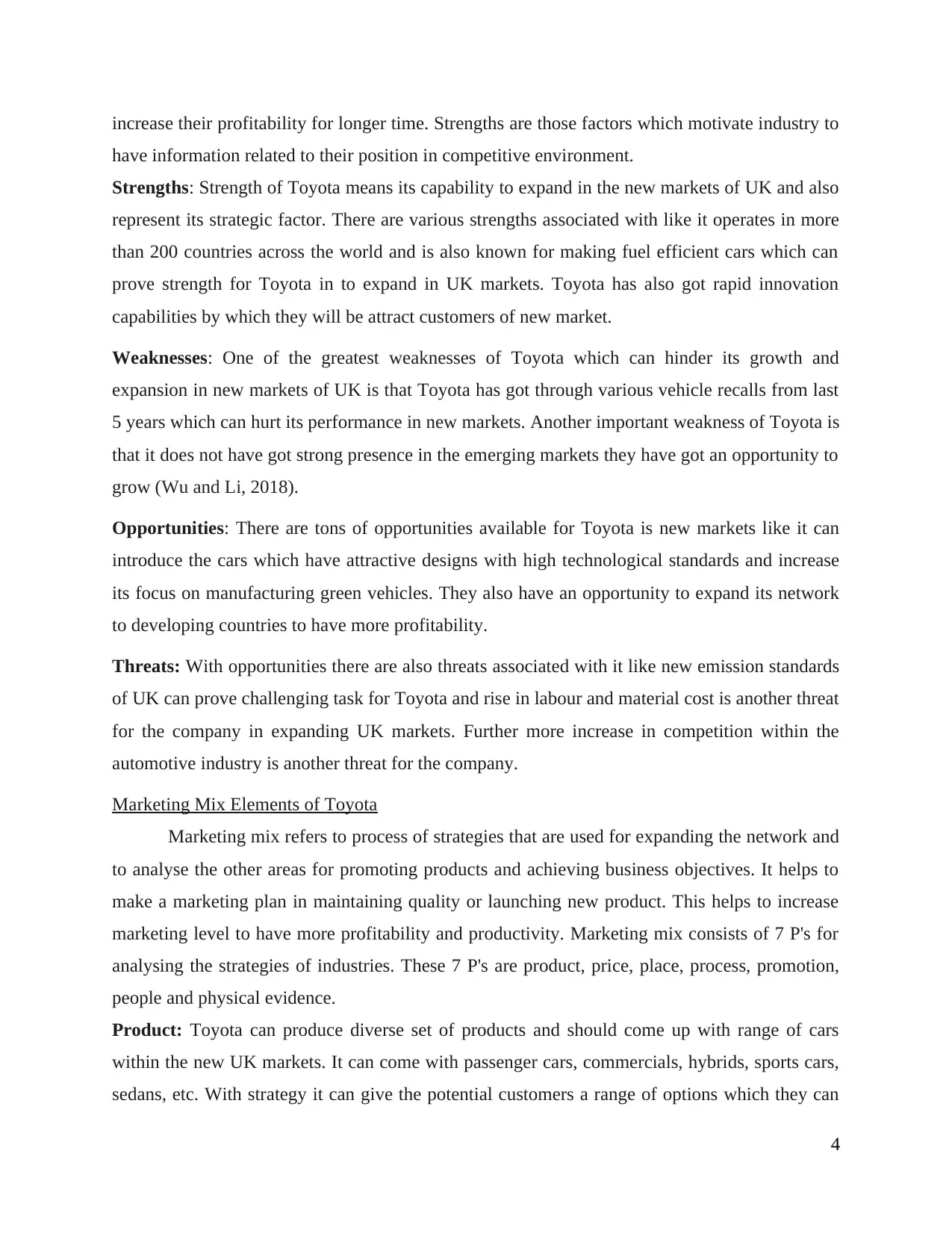
increase their profitability for longer time. Strengths are those factors which motivate industry to
have information related to their position in competitive environment.
Strengths: Strength of Toyota means its capability to expand in the new markets of UK and also
represent its strategic factor. There are various strengths associated with like it operates in more
than 200 countries across the world and is also known for making fuel efficient cars which can
prove strength for Toyota in to expand in UK markets. Toyota has also got rapid innovation
capabilities by which they will be attract customers of new market.
Weaknesses: One of the greatest weaknesses of Toyota which can hinder its growth and
expansion in new markets of UK is that Toyota has got through various vehicle recalls from last
5 years which can hurt its performance in new markets. Another important weakness of Toyota is
that it does not have got strong presence in the emerging markets they have got an opportunity to
grow (Wu and Li, 2018).
Opportunities: There are tons of opportunities available for Toyota is new markets like it can
introduce the cars which have attractive designs with high technological standards and increase
its focus on manufacturing green vehicles. They also have an opportunity to expand its network
to developing countries to have more profitability.
Threats: With opportunities there are also threats associated with it like new emission standards
of UK can prove challenging task for Toyota and rise in labour and material cost is another threat
for the company in expanding UK markets. Further more increase in competition within the
automotive industry is another threat for the company.
Marketing Mix Elements of Toyota
Marketing mix refers to process of strategies that are used for expanding the network and
to analyse the other areas for promoting products and achieving business objectives. It helps to
make a marketing plan in maintaining quality or launching new product. This helps to increase
marketing level to have more profitability and productivity. Marketing mix consists of 7 P's for
analysing the strategies of industries. These 7 P's are product, price, place, process, promotion,
people and physical evidence.
Product: Toyota can produce diverse set of products and should come up with range of cars
within the new UK markets. It can come with passenger cars, commercials, hybrids, sports cars,
sedans, etc. With strategy it can give the potential customers a range of options which they can
4
have information related to their position in competitive environment.
Strengths: Strength of Toyota means its capability to expand in the new markets of UK and also
represent its strategic factor. There are various strengths associated with like it operates in more
than 200 countries across the world and is also known for making fuel efficient cars which can
prove strength for Toyota in to expand in UK markets. Toyota has also got rapid innovation
capabilities by which they will be attract customers of new market.
Weaknesses: One of the greatest weaknesses of Toyota which can hinder its growth and
expansion in new markets of UK is that Toyota has got through various vehicle recalls from last
5 years which can hurt its performance in new markets. Another important weakness of Toyota is
that it does not have got strong presence in the emerging markets they have got an opportunity to
grow (Wu and Li, 2018).
Opportunities: There are tons of opportunities available for Toyota is new markets like it can
introduce the cars which have attractive designs with high technological standards and increase
its focus on manufacturing green vehicles. They also have an opportunity to expand its network
to developing countries to have more profitability.
Threats: With opportunities there are also threats associated with it like new emission standards
of UK can prove challenging task for Toyota and rise in labour and material cost is another threat
for the company in expanding UK markets. Further more increase in competition within the
automotive industry is another threat for the company.
Marketing Mix Elements of Toyota
Marketing mix refers to process of strategies that are used for expanding the network and
to analyse the other areas for promoting products and achieving business objectives. It helps to
make a marketing plan in maintaining quality or launching new product. This helps to increase
marketing level to have more profitability and productivity. Marketing mix consists of 7 P's for
analysing the strategies of industries. These 7 P's are product, price, place, process, promotion,
people and physical evidence.
Product: Toyota can produce diverse set of products and should come up with range of cars
within the new UK markets. It can come with passenger cars, commercials, hybrids, sports cars,
sedans, etc. With strategy it can give the potential customers a range of options which they can
4
⊘ This is a preview!⊘
Do you want full access?
Subscribe today to unlock all pages.

Trusted by 1+ million students worldwide
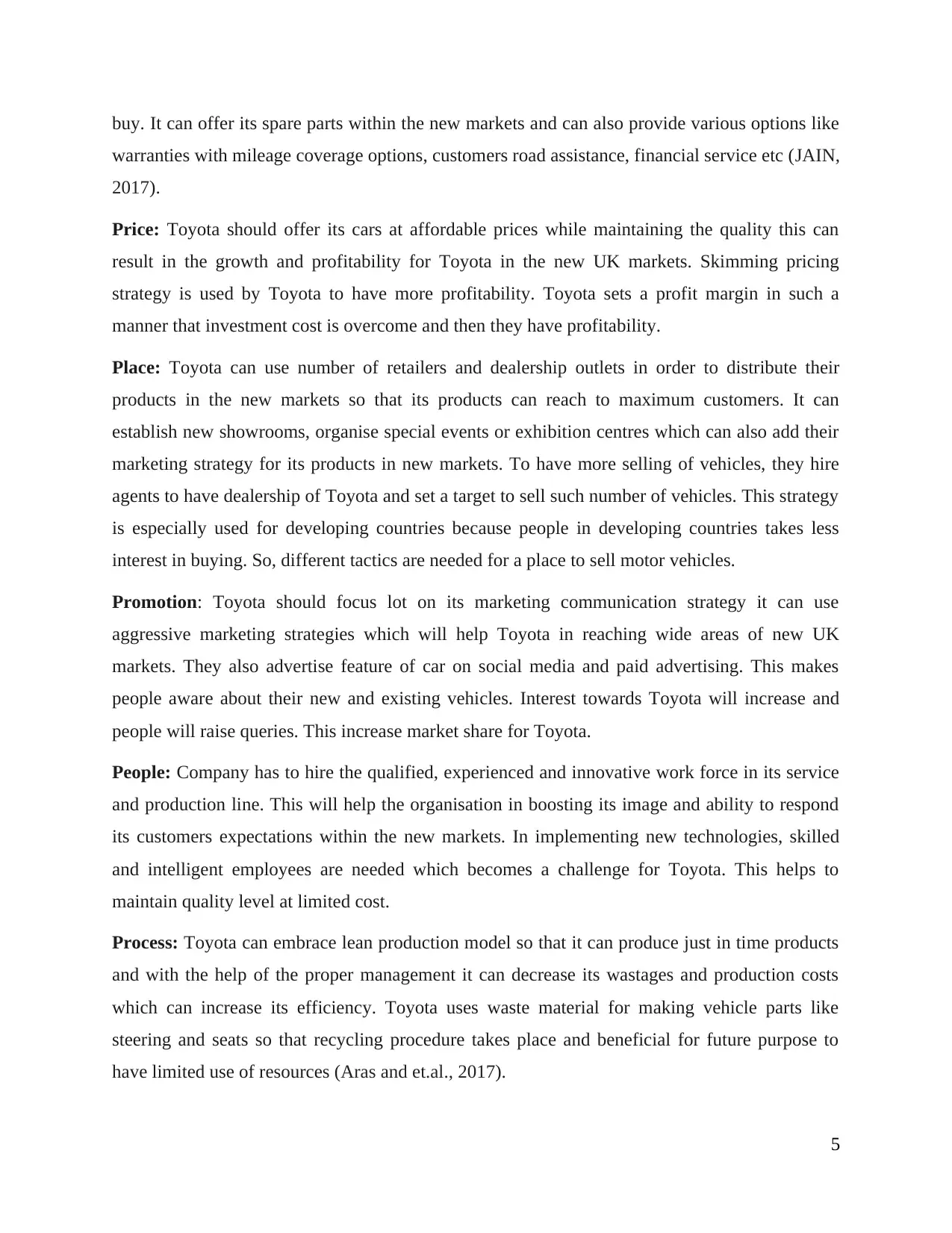
buy. It can offer its spare parts within the new markets and can also provide various options like
warranties with mileage coverage options, customers road assistance, financial service etc (JAIN,
2017).
Price: Toyota should offer its cars at affordable prices while maintaining the quality this can
result in the growth and profitability for Toyota in the new UK markets. Skimming pricing
strategy is used by Toyota to have more profitability. Toyota sets a profit margin in such a
manner that investment cost is overcome and then they have profitability.
Place: Toyota can use number of retailers and dealership outlets in order to distribute their
products in the new markets so that its products can reach to maximum customers. It can
establish new showrooms, organise special events or exhibition centres which can also add their
marketing strategy for its products in new markets. To have more selling of vehicles, they hire
agents to have dealership of Toyota and set a target to sell such number of vehicles. This strategy
is especially used for developing countries because people in developing countries takes less
interest in buying. So, different tactics are needed for a place to sell motor vehicles.
Promotion: Toyota should focus lot on its marketing communication strategy it can use
aggressive marketing strategies which will help Toyota in reaching wide areas of new UK
markets. They also advertise feature of car on social media and paid advertising. This makes
people aware about their new and existing vehicles. Interest towards Toyota will increase and
people will raise queries. This increase market share for Toyota.
People: Company has to hire the qualified, experienced and innovative work force in its service
and production line. This will help the organisation in boosting its image and ability to respond
its customers expectations within the new markets. In implementing new technologies, skilled
and intelligent employees are needed which becomes a challenge for Toyota. This helps to
maintain quality level at limited cost.
Process: Toyota can embrace lean production model so that it can produce just in time products
and with the help of the proper management it can decrease its wastages and production costs
which can increase its efficiency. Toyota uses waste material for making vehicle parts like
steering and seats so that recycling procedure takes place and beneficial for future purpose to
have limited use of resources (Aras and et.al., 2017).
5
warranties with mileage coverage options, customers road assistance, financial service etc (JAIN,
2017).
Price: Toyota should offer its cars at affordable prices while maintaining the quality this can
result in the growth and profitability for Toyota in the new UK markets. Skimming pricing
strategy is used by Toyota to have more profitability. Toyota sets a profit margin in such a
manner that investment cost is overcome and then they have profitability.
Place: Toyota can use number of retailers and dealership outlets in order to distribute their
products in the new markets so that its products can reach to maximum customers. It can
establish new showrooms, organise special events or exhibition centres which can also add their
marketing strategy for its products in new markets. To have more selling of vehicles, they hire
agents to have dealership of Toyota and set a target to sell such number of vehicles. This strategy
is especially used for developing countries because people in developing countries takes less
interest in buying. So, different tactics are needed for a place to sell motor vehicles.
Promotion: Toyota should focus lot on its marketing communication strategy it can use
aggressive marketing strategies which will help Toyota in reaching wide areas of new UK
markets. They also advertise feature of car on social media and paid advertising. This makes
people aware about their new and existing vehicles. Interest towards Toyota will increase and
people will raise queries. This increase market share for Toyota.
People: Company has to hire the qualified, experienced and innovative work force in its service
and production line. This will help the organisation in boosting its image and ability to respond
its customers expectations within the new markets. In implementing new technologies, skilled
and intelligent employees are needed which becomes a challenge for Toyota. This helps to
maintain quality level at limited cost.
Process: Toyota can embrace lean production model so that it can produce just in time products
and with the help of the proper management it can decrease its wastages and production costs
which can increase its efficiency. Toyota uses waste material for making vehicle parts like
steering and seats so that recycling procedure takes place and beneficial for future purpose to
have limited use of resources (Aras and et.al., 2017).
5
Paraphrase This Document
Need a fresh take? Get an instant paraphrase of this document with our AI Paraphraser
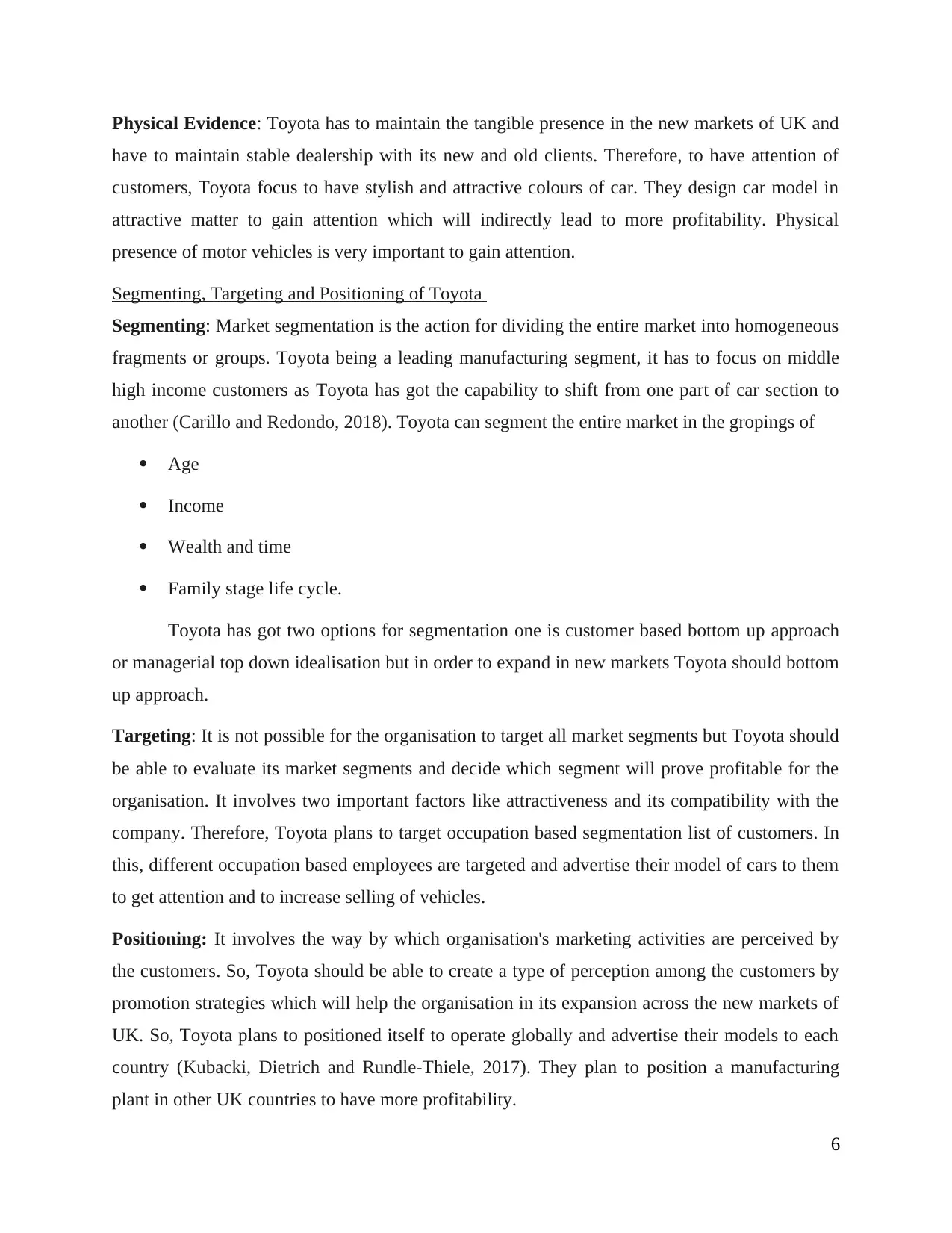
Physical Evidence: Toyota has to maintain the tangible presence in the new markets of UK and
have to maintain stable dealership with its new and old clients. Therefore, to have attention of
customers, Toyota focus to have stylish and attractive colours of car. They design car model in
attractive matter to gain attention which will indirectly lead to more profitability. Physical
presence of motor vehicles is very important to gain attention.
Segmenting, Targeting and Positioning of Toyota
Segmenting: Market segmentation is the action for dividing the entire market into homogeneous
fragments or groups. Toyota being a leading manufacturing segment, it has to focus on middle
high income customers as Toyota has got the capability to shift from one part of car section to
another (Carillo and Redondo, 2018). Toyota can segment the entire market in the gropings of
Age
Income
Wealth and time
Family stage life cycle.
Toyota has got two options for segmentation one is customer based bottom up approach
or managerial top down idealisation but in order to expand in new markets Toyota should bottom
up approach.
Targeting: It is not possible for the organisation to target all market segments but Toyota should
be able to evaluate its market segments and decide which segment will prove profitable for the
organisation. It involves two important factors like attractiveness and its compatibility with the
company. Therefore, Toyota plans to target occupation based segmentation list of customers. In
this, different occupation based employees are targeted and advertise their model of cars to them
to get attention and to increase selling of vehicles.
Positioning: It involves the way by which organisation's marketing activities are perceived by
the customers. So, Toyota should be able to create a type of perception among the customers by
promotion strategies which will help the organisation in its expansion across the new markets of
UK. So, Toyota plans to positioned itself to operate globally and advertise their models to each
country (Kubacki, Dietrich and Rundle-Thiele, 2017). They plan to position a manufacturing
plant in other UK countries to have more profitability.
6
have to maintain stable dealership with its new and old clients. Therefore, to have attention of
customers, Toyota focus to have stylish and attractive colours of car. They design car model in
attractive matter to gain attention which will indirectly lead to more profitability. Physical
presence of motor vehicles is very important to gain attention.
Segmenting, Targeting and Positioning of Toyota
Segmenting: Market segmentation is the action for dividing the entire market into homogeneous
fragments or groups. Toyota being a leading manufacturing segment, it has to focus on middle
high income customers as Toyota has got the capability to shift from one part of car section to
another (Carillo and Redondo, 2018). Toyota can segment the entire market in the gropings of
Age
Income
Wealth and time
Family stage life cycle.
Toyota has got two options for segmentation one is customer based bottom up approach
or managerial top down idealisation but in order to expand in new markets Toyota should bottom
up approach.
Targeting: It is not possible for the organisation to target all market segments but Toyota should
be able to evaluate its market segments and decide which segment will prove profitable for the
organisation. It involves two important factors like attractiveness and its compatibility with the
company. Therefore, Toyota plans to target occupation based segmentation list of customers. In
this, different occupation based employees are targeted and advertise their model of cars to them
to get attention and to increase selling of vehicles.
Positioning: It involves the way by which organisation's marketing activities are perceived by
the customers. So, Toyota should be able to create a type of perception among the customers by
promotion strategies which will help the organisation in its expansion across the new markets of
UK. So, Toyota plans to positioned itself to operate globally and advertise their models to each
country (Kubacki, Dietrich and Rundle-Thiele, 2017). They plan to position a manufacturing
plant in other UK countries to have more profitability.
6
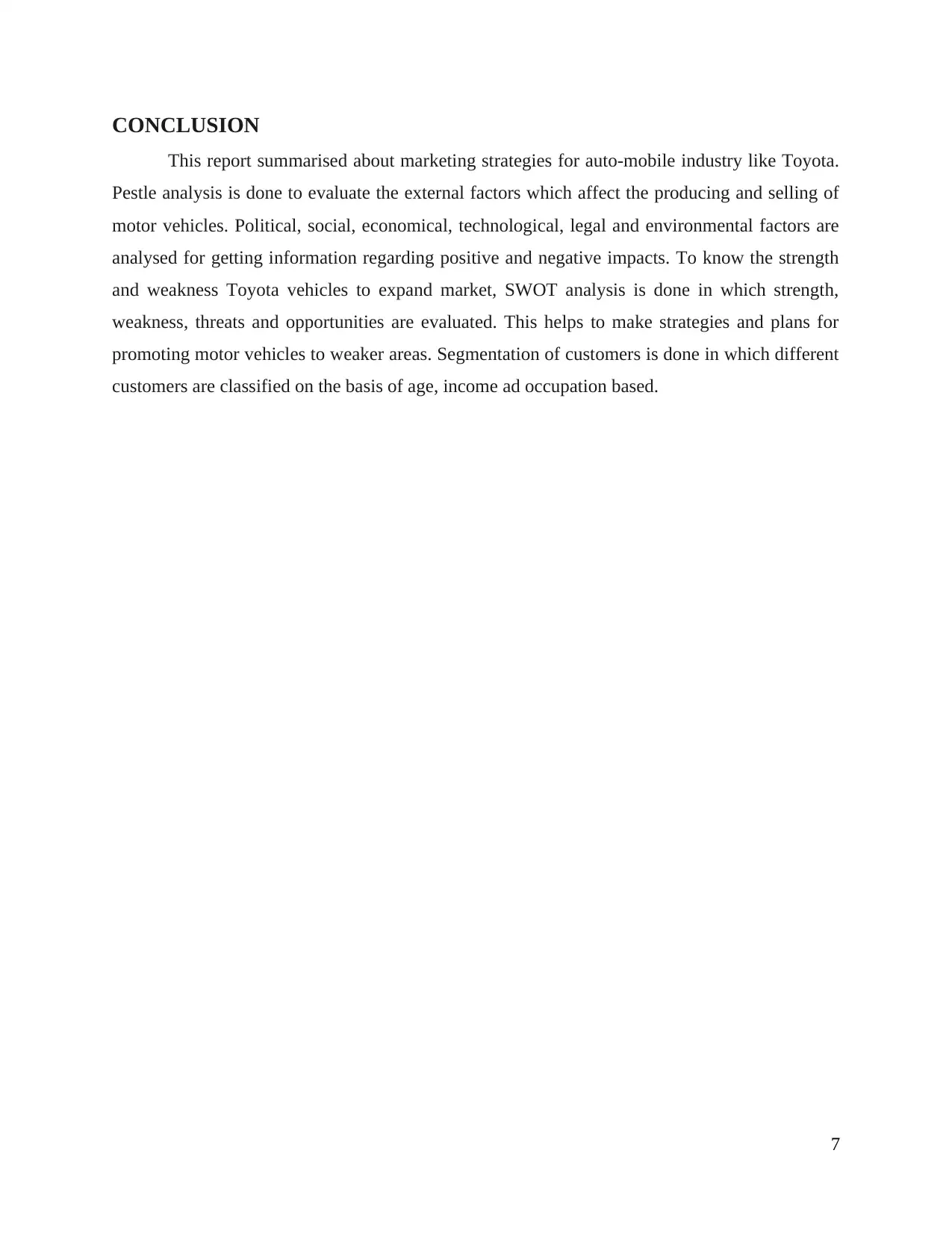
CONCLUSION
This report summarised about marketing strategies for auto-mobile industry like Toyota.
Pestle analysis is done to evaluate the external factors which affect the producing and selling of
motor vehicles. Political, social, economical, technological, legal and environmental factors are
analysed for getting information regarding positive and negative impacts. To know the strength
and weakness Toyota vehicles to expand market, SWOT analysis is done in which strength,
weakness, threats and opportunities are evaluated. This helps to make strategies and plans for
promoting motor vehicles to weaker areas. Segmentation of customers is done in which different
customers are classified on the basis of age, income ad occupation based.
7
This report summarised about marketing strategies for auto-mobile industry like Toyota.
Pestle analysis is done to evaluate the external factors which affect the producing and selling of
motor vehicles. Political, social, economical, technological, legal and environmental factors are
analysed for getting information regarding positive and negative impacts. To know the strength
and weakness Toyota vehicles to expand market, SWOT analysis is done in which strength,
weakness, threats and opportunities are evaluated. This helps to make strategies and plans for
promoting motor vehicles to weaker areas. Segmentation of customers is done in which different
customers are classified on the basis of age, income ad occupation based.
7
⊘ This is a preview!⊘
Do you want full access?
Subscribe today to unlock all pages.

Trusted by 1+ million students worldwide

REFERENCES
Books and Journals
Aras, M. and et.al., 2017, July. The effect of service marketing mix on consumer decision
making. In International Conference on Education, Science, Art and Technology (pp.
108-112).
Baker, M.J., 2016. What is marketing?. In The Marketing Book (pp. 25-42). Routledge.
Carillo, C.J.B. and Redondo, R.P., 2018. Decision Making Under the Multicriteria Approach to
Identify Marketing Mix Strategies.
GREEN, M.C.K. and WARREN, J., 2019. GLOBAL MARKETING. Pearson.
Holbrook, M.B., 2018. Creating value: the theory and practice of marketing semiotics research.
JAIN, M.K., 2017. An analysis of marketing mix: 7Ps or more. International Journal of Advance
Higher Education Research & Development. 1(7).
Kubacki, K., Dietrich, T. and Rundle-Thiele, S., 2017. Segmentation in social marketing: why
we should do it more often that we currently do. In Segmentation in Social
Marketing (pp. 1-6). Springer, Singapore.
Monden, Y., 2018. Toyota management system: Linking the seven key functional areas.
Routledge.
Rao, C.P. and Kurtz, D.L., 2015. Marketing strategies for reaching minority markets. In Minority
Marketing: Research Perspectives for the 1990s (pp. 1-7). Springer, Cham.
Wu, Y.L. and Li, E.Y., 2018. Marketing mix, customer value, and customer loyalty in social
commerce: A stimulus-organism-response perspective. Internet Research. 28(1). pp.74-
104.
Online
Haseeb., 2017. Pestle Analysis of Toyota. [Online]. Available Through:
<http://marketingdawn.com/pestle-analysis-of-toyota/>.
Marketing Mix - Meaning and its Elements. 2019. [Online]. Available Through:
<https://www.managementstudyguide.com/target-market-selection.htm>.
8
Books and Journals
Aras, M. and et.al., 2017, July. The effect of service marketing mix on consumer decision
making. In International Conference on Education, Science, Art and Technology (pp.
108-112).
Baker, M.J., 2016. What is marketing?. In The Marketing Book (pp. 25-42). Routledge.
Carillo, C.J.B. and Redondo, R.P., 2018. Decision Making Under the Multicriteria Approach to
Identify Marketing Mix Strategies.
GREEN, M.C.K. and WARREN, J., 2019. GLOBAL MARKETING. Pearson.
Holbrook, M.B., 2018. Creating value: the theory and practice of marketing semiotics research.
JAIN, M.K., 2017. An analysis of marketing mix: 7Ps or more. International Journal of Advance
Higher Education Research & Development. 1(7).
Kubacki, K., Dietrich, T. and Rundle-Thiele, S., 2017. Segmentation in social marketing: why
we should do it more often that we currently do. In Segmentation in Social
Marketing (pp. 1-6). Springer, Singapore.
Monden, Y., 2018. Toyota management system: Linking the seven key functional areas.
Routledge.
Rao, C.P. and Kurtz, D.L., 2015. Marketing strategies for reaching minority markets. In Minority
Marketing: Research Perspectives for the 1990s (pp. 1-7). Springer, Cham.
Wu, Y.L. and Li, E.Y., 2018. Marketing mix, customer value, and customer loyalty in social
commerce: A stimulus-organism-response perspective. Internet Research. 28(1). pp.74-
104.
Online
Haseeb., 2017. Pestle Analysis of Toyota. [Online]. Available Through:
<http://marketingdawn.com/pestle-analysis-of-toyota/>.
Marketing Mix - Meaning and its Elements. 2019. [Online]. Available Through:
<https://www.managementstudyguide.com/target-market-selection.htm>.
8
1 out of 10
Related Documents
Your All-in-One AI-Powered Toolkit for Academic Success.
+13062052269
info@desklib.com
Available 24*7 on WhatsApp / Email
![[object Object]](/_next/static/media/star-bottom.7253800d.svg)
Unlock your academic potential
Copyright © 2020–2025 A2Z Services. All Rights Reserved. Developed and managed by ZUCOL.





